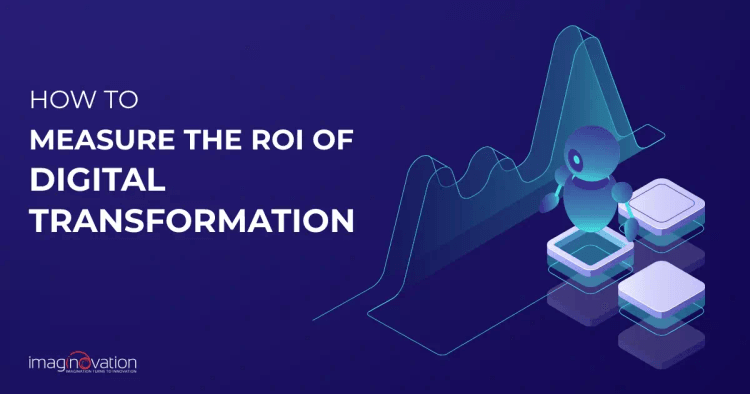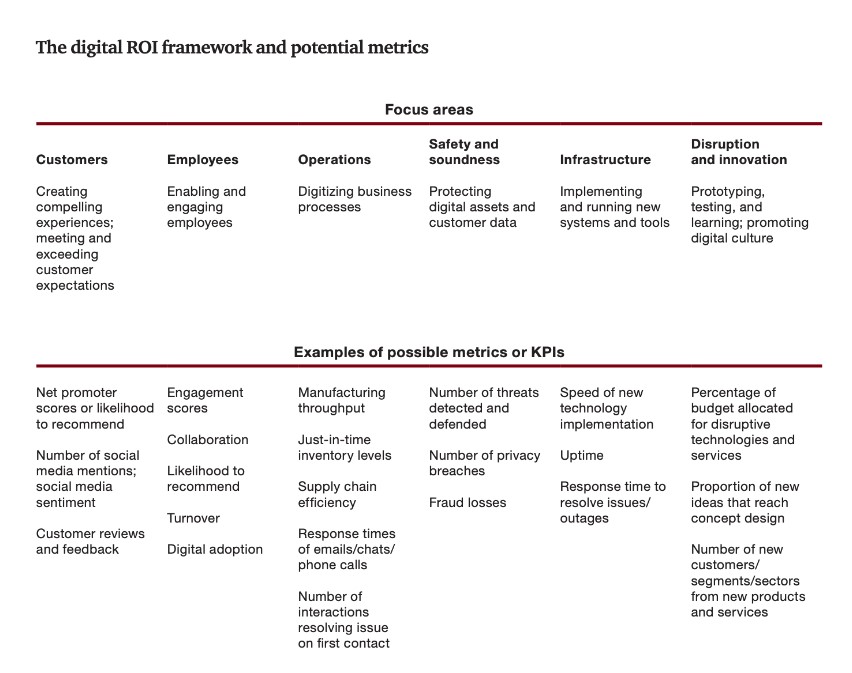With its ability to bring efficiency and modernization, digital transformation remains a top priority in today’s constantly evolving business world.
But how do you measure the return on investment (ROI) of your digital transformation initiative? In other words, how do you determine whether your digital transformation efforts are yielding results and are worth the continued investment? This is a crucial question for any organization looking to undergo a digital transformation.
A common pitfall for many organizations investing in digital transformation is the lack of proper metrics to measure ROI.
This guide will help you ensure that your digital transformation efforts are paying off.
You will learn how to measure the ROI of your digital transformation initiatives, helping you make more informed decisions about your transformation strategies. We’ll also highlight the key factors that influence ROI.
Let’s get started!
Understanding Key Digital Transformation Metrics
Digital transformation can be a double-edged sword.
No matter how much you hasten to adopt the best digital solution and meet your objectives efficiently, careful consideration of key metrics is vital.
But metrics vary according to the digital transformation goals of a business.
Before you start evaluating your investment, ask yourself this question: "Why are we doing this?" The answer will help you decide what statistics to use in measuring success.
Figure out if, by digital transformation, you’re trying to boost transparency, operational efficiency, employee engagement, or something else.
You have to choose metrics that are very specific to your industry and business. For example, if you want to measure increased revenue and cost savings, you can't use the same metrics as a company trying to increase the number of likes on its Instagram page.
Tailoring and aligning your own metrics and KPIs to your specific goals can be tricky. However, here are some common metrics you can use to measure digital transformation success.
1. Return on Digital Investments
Digital transformation can be expensive.
In the digital transformation journey, leaders need to be sure that they are getting a return on their investment in technology adoption.
This is why return on investment (ROI) remains one of the most popular KPIs of digital transformation. After all, you’d want to know if you're getting your money's worth when purchasing new technology.
The return on digital investments tells you how much revenue you can bring in since making the transition, compared to how much you spent on new technology and other expenses related to its adoption.
While this can be a strong indicator of success, it's important to remember that returns can take time to appear.
Your ROI will likely seem small in the first few phases of transformation, but measuring long-term can show you how successful the initiative was.
2. Workforce productivity metrics

Productivity metrics assess if your employees can complete more work in less time. But don't assume that all digital transformation initiatives make your employees more productive.
New technology and processes can make your employees more productive or become less productive.
Before you start measuring employee productivity, you must first decide what "productivity" means to you. For example, are you interested in reducing the time an employee spends on a task? Or do you want them to be able to complete more tasks in the same amount of time?
Remember that employees will require time to adjust and get the most out of your digital transformation, but keep an eye on how they progress. If their productivity declines or plateau before reaching your final goal, it might be time for additional support or training.
For instance, if you invest in a tool to help your IT team handle customer support tickets, you need to measure the number of tickets they handled before and after implementing the new digital tool.
If you wish to identify whether new tools will help you improve workforce productivity, you must find answers to questions like:
- Are your employees able to optimize their work hours?
- How engaged do they remain in the process?
- Is task automation freeing up time for strategic thinking?
- Are they able to solve complex problems more quickly than before?
3. Customer experience metrics
If you focus on engaging your customers/users, you'll be able to move forward with your digital transformation project.
Remember, to keep customers coming back; you must keep them happy. That means measuring how they're engaging with and using your platform. One way to do this is by asking them questions about their experience so that you can pinpoint what needs improvement.
You can use customer experience metrics like customer effort score (CES), net promoter score (NPS), and customer satisfaction (CSAT) to see if your audience is connecting with your digital presence.
These metrics use data from website traffic sources, subscriptions, or signups.
4. Digital adoption
Digital adoption metrics measure how employees and users interact with specific tools or platforms. Popular adoption metrics include:
- Daily/monthly active users - They are the people who use your product every day or month.
- Adoption rate - It compares the number of active users with the total number of users.
- Average time spent using a feature - It is just what it sounds like: how much time people spend using that particular feature.
- Retention - It lets you know how many people continue to use your product after some time has passed.
Adoption metrics can show how well your team adjusts to your new product, platform, or features. If adoption is low, it might be time to make a change. Or they may need additional training.
5. Time to market
Time is money, the saying goes; but time is also a valuable asset in its own right.
That's why it should be one of the most critical digital transformation metrics for businesses across industries.
If you don't reach the market faster than your competitors, they will overtake you.
And while there is no end point to digital transformation, the goals or milestones that comprise that strategy should have some time-based measurement.
The speed with which you can deliver is a critical factor in measuring the success of this journey.
6. Organizational culture alignment
Your best digital strategy is only helpful if your workforce is supportive.
Before making any significant investments, look at your current culture. What changes need to occur to ensure your people embrace the values that the digital transformation embodies?
If your digital transformation is misaligned with your culture, you may experience slow user adoption, low productivity, and other problems.
Digital culture has several characteristics: flexibility/agility, digital awareness, ecosystem orientation, employee engagement, risk-taking culture, and internal knowledge sharing.
See if your workforce has adopted these in their day-to-day work and behavior.
Step-by-Step Guide to Measuring ROI of Digital Transformation
How do you know if your digital transformation efforts are effective?
You measure the ROI.
Don't worry! The process is less overwhelming than you might feel.
Here's a simple, step-by-step framework you can use to measure the ROI of your digital transformation efforts.
Step 1: Revisit the objectives of your digital transformation project

For every project, you have to look at the expected outcomes.
So, before calculating the return on investment, ensure you know what you're trying to achieve. Ask yourself what you want to change or improve with the digital transformation project.
The outcome of your digital transformation project will depend on what you want to achieve.
Defining your objectives through a project statement gives you a clearer target.
Furthermore, a well-defined objective will make measuring your project's ROI and success easier! Because you already know precisely what you want to achieve.
Begin by focusing on one (the most essential) digital transformation goal for a specific period. It should be the one with the best positive effect on the entire organization.
Identifying a single goal will help you plan specific strategies, use appropriate measures, and effectively use the company's existing resources.
For example, a logistics enterprise might want to improve supply chain visibility and boost fleet productivity with digitization. If more customers place orders during the holidays, this enterprise must prioritize improving fleet productivity to deliver the goods quickly.
So you can set the right ROI target by first setting a clear and concise digital transformation goal.
Step 2: Determine the cost structure of your business
You must know how much it costs to calculate your return on investment (ROI) for a digital transformation project.
The costs include the expenses incurred on hardware and software and other ongoing costs such as maintenance and support.
Additionally, it would be best if you considered labor costs associated with implementing and managing the project, including hiring or training employees and payment to a digital transformation consulting agency for managing the project.
To determine whether your current cost structure aligns with your digital transformation goals, you need to review your existing cost structure and answer these questions:
- Which activities are cost-effective and which aren’t?
- Do you need to invest more or cut down costs in any activities?
- What adjustments should you make to align the current cost structure with your digital transformation goals?
Next, research the amount of money you should invest and what it will be used for--staffing, infrastructure, technology, etc.
Consider both hard and soft costs when determining the return on investment (ROI) of your digitalization around quality innovation.
Hard costs are definitive monetary figures that are applied toward the implementation of a solution. They are calculated by answering questions like - How much will I pay for this solution versus another?
Soft savings, however, are less tangible but equally as important. They include decreased employee stress levels from automation, better customer service, and increased satisfaction.
Step 3: Determine the potential benefits and identify all value metrics
The next important step is establishing clear success metrics linked to value creation and delivery.
Make sure you assess and analyze your digital ROI by tying the right metrics to the right goals. This must be done from the perspectives of customers, partners, shareholders, and communities.
These metrics should be updated regularly to track project progress, ensuring that you're making the most of your investment while on your digital journey to meet the desired outcomes.
Keep in mind that each ROI goal needs different metrics. But these metrics must be able to measure key business processes and strategic performance against benchmarks.
They should help track improvements made over time and improve the speed and quality of decision-making for overall quality innovation.
Each metric should meet the SMART test: Specific (what?), Measurable (how many?), Achievable (will it happen?), Result-oriented (will it help?), and Time-based (when?).
Here is a digital ROI framework proposed by PwC. This framework focuses on six key areas: customers, employees, business operations, safety, infrastructure, and disruption and innovation.
(Source)
Ensure you consider all the key aspects impacting business revenue due to your digitization efforts.
Make sure you assign a financial value to metrics that are otherwise impossible to calculate.
For example, you could assign a lifetime value to a customer who rates you highly after a second purchase. Later on, this information could be used to calculate improved customer scores.
Step 4: Set up realistic but clear expectations and milestones
Have a firm grasp of your digital transformation initiative's milestones and timeframes. Set up clear expectations.
If you don't, you may be overcome with motivation at the beginning of the project, only to find yourself setting unrealistic goals because you didn't take a longer view.
For example, when building an app to improve customer experience, it's easy to assume that reducing inbound call levels is a success factor (which is not entirely accurate); however, if you adopt a longer view, you'll see that your customers are experiencing significant benefits because of the new digital services you're creating.
To measure ROI accurately and timely, you must set specific timelines for each metric. These could be a month or a quarter or be tied to the project timeline.
You can then optionally measure each indicator or the entire index to assess your digital transformation efforts.
Step 5: Analyze outcomes regularly
Business leaders can't judge whether digital transformation is effective just by looking at ROI results in a short period without comparing them with other time periods.
Since digital transformation is a long and arduous process of change, businesses can't expect results overnight.
Thus, measuring ROI consistently allows leaders to assess digital transformation progress periodically.
From there, businesses can determine whether the current way of doing things is suitable and make adjustments as needed.
This way, identifying and addressing problems becomes more manageable, preventing them from becoming bigger issues.
Factors that Affect the ROI of Digital Transformation
Calculating ROI is easy if you've already got a well-established product, but it gets tricky when your company breaks into a new market with an innovative product.
Things become even more complicated when trying to innovate with a new service or technology.
When calculating ROI, focus on critical factors such as total revenue, market value, and year-over-year growth figures to get the most out of your digital transformation.
Here are some of the critical factors you must keep in mind when calculating the ROI of your business's digital innovation efforts:
1. Exploring & understanding customer needs
This is perhaps one of the essential factors for your company's digital transformation.
Make sure your digitization efforts lead to delivering digital experiences that match your customer expectations.
To do so, collect and analyze customer feedback based on their interactions on your company's social handles and client portals.
2. Investing in digital innovations
Businesses must work on digitizing business processes to make customer experiences more engaging and improve workflow.
Implementing new digital systems and tools is imperative if you want your company's work culture to be collaborative and in tune with the latest technological trends.
3. Data-driven decisions

Data is your guide in the digital transformation process.
Your focus should be on getting meaningful, actionable information so you can make decisions that add value to your digital innovation initiatives.
It helps you make decisions that add value to your innovation initiatives.
Past purchasing behavior, customer reviews and feedback, and sales figures are a few metrics that form data-based decisions.
4. Regular performance tracking
If you want to improve sales, revenue, and customer satisfaction, you need to constantly prototype, test, and promote a digital culture.
You also need to regularly monitor your digital transformation efforts.
The faster you adopt new technology in your businesses, the more effective your digital innovation initiatives will be.
How to Boost the ROI of Your Digital Transformation Initiative
One of the top-level executives' most common concerns about digital transformation initiatives is their ROI.
How can they ensure a boost in return on investment in their digital transformation endeavors?
Trying to improve your return on investment can be an overwhelming task, but here are some tips to help you get started.
Check them out!
- Set a clear vision for your digital transformation goals and objectives. If you don't do it, you could have some pretty bad results.
- Set expectations for growth of ROI on your newly adopted digital transformation. Digital transformation is not a one-size-fits-all strategy. Therefore, flexibility, or the ability to adapt to changing circumstances, is essential to drive efforts with potential innovation.
- Build an ROI model well in advance. It’s also vital that leaders build a "Return on Investment" model beforehand to measure how well they met their objectives.
- Keep the ideal target audience in mind. The right customer base points the way to digital transformation opportunities. Discover how to diversify your customer base, increase touchpoints, and raise conversion rates.
- Carefully assess all technologies. Not every new technology is right for every organization. Some technologies are more suited for certain situations than others. It is vital to consider the ROI a particular technology can deliver in your specific case before deciding which one to use.
- Introduce changes slowly. Smaller doses of emerging technology in the workplace allow employees to become comfortable with new workflows. This also gives an organization time to scale back on digital services and experiment with other new technologies that are evolving and increasing at breakneck speed.
- Communicate clearly. When going through any change management undertaking--and digital transformation is one--make sure you communicate clearly, frequently, and to the right set of people.
- Regularly track and evaluate your performance and ROI. It allows you to adjust any key performance indicators if required.
Maximize Your Digital Transformation ROI With Imaginovation
Digital transformation is a rather complex undertaking, but you don’t have to do it alone.
Imaginovation delivers the right resources and expertise to help you implement digital technologies transforming how you deliver services, target new customers, and compete effectively.
We can provide the necessary expertise to help you navigate the often-complicated process of a digital transformation journey.
Contact us to learn how we can tailor a customized solution for you that helps you establish a return on investment on your digital initiative.
We have a proven track record of success in delivering digital transformation initiatives across industries. So we understand that there's no "one-size-fits-all" when it comes to your digital transformation project.
We customize our digital transformation services to your unique needs and promise the best results.
Imaginovation is an award-winning web and mobile app development company with vast experience crafting remarkable digital success stories for diverse companies.
Let's talk.
Ready to build an app, but not sure where to start?
We've got you covered. Click the button below to get started.






